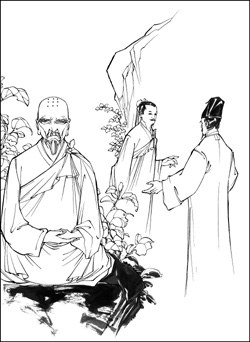


当时中国的佛法似有似无,好像有佛法,又好像没有佛法。为什么这么说?因为当时虽有佛法,但只是在那儿做表面工作,诵经呀、研究经典呀、讲经呀,甚至于连拜忏都没有;当时一般的学者就这么拿着佛法当学问来讨论研究。
但是经典所说的道理是应该修行的,可是没什么人修行。为什么没有人修行?就因为都怕苦;没有什么人真正打坐。除了当时有一位志公祖师是参禅打坐的,也是得
五眼的外;一般人都怕苦,不修行,没有认真去参禅打坐。也就好像现在你们一样,坐在那儿,等一等腿痛了,就想把腿伸开摇摇晃晃地磨擦一下。因为人都是人嘛!都怕吃苦,当时就有这种情形,和现在差不多。这叫似有佛法而没有佛法,似有似无。

At that time, the Buddhadharma seemed to exist in China, but it really did not. It was as if it were and yet weren't there. That is because the work being done was superficial. There were few who recited Sutras, investigated the Sutra texts, or explained the Sutras, and virtually no one bowed repentance ceremonies. Ordinary scholars regarded Buddhism as a field of study and engaged in debates and discussions about it. But the principles in the Sutras should be cultivated! However, nobody was cultivating. Why not?
People were afraid of suffering. No one truly meditated. Well, there was Venerable Patriarch Zhi, who practiced meditation and attained the Five Eyes. But most people feared suffering and didn't cultivate. No one seriously investigated Chan and sat in meditation, just like you people now who sit in meditation for a while until your legs begin to hurt. When their legs began to ache, they would wince and fidget and then gently unbend and rub them. People are just people and everyone avoids suffering as much as possible. That's the way it was then; that's the way it is now. That's called Buddhadharma seeming to be there but not really being there.